Alexandropol: Making the “Orphan City”
This dispatch is the first in a series about Alexandropol.
If one of your relatives grew up in a Near East Relief orphanage in Armenia, there is a good chance he or she lived in Alexandropol – a complex of three orphanages that housed more than 22,000 children at its peak.
The Armenian Genocide sent waves of refugees into the harsh terrain of the Caucasus Mountains. By the summer of 1919, the orphan and refugee situation in the Caucasus region had reached a new level of desperation. Supplies at the Near East Relief stations were alarmingly scarce. The threat of famine loomed over the refugee community.

Waiting for admission to the orphanage at Alexandropol, c. 1920.
A Staggering Need
In an August 1919 letter to the New York Times, American Red Cross nurse Blanche Knox (who later became a Near East Relief worker) reported that refugees were dying at a rate of 200 people per day. Knox also referred to an orphanage where 700 children were surviving on one pound of bread per day and a thin soup made of oil, water, and rice.
Most Near East Relief stations in the Caucasus were located inland, and nearly all supplies for the region traveled by freighter from the U.S. to the port city of Batum (now Batumi, Georgia) on the Black Sea. The supplies were then shipped to Alexandropol, an important railroad hub. Former Russian Imperial trains carried the supplies on to Erivan (now Yerevan), Tabriz, Tiflis (now Tblisi, Georgia), and Kars for distribution to orphans and refugees.

Armenian refugee women in the Caucasus, c. 1920.
From Army Base to Orphanage
Alexandropol had been a key military location for the Russian army in the late 1800s. By 1919, Kazachi, Seversky, and Polygon Posts had been empty for many years. Near East Relief saw potential in the dilapidated buildings: by consolidating its orphanage operations into one large complex, the organization could care for many more children in need. The Armenian government agreed to let Near East Relief use the former army base.
Dubbed the “Orphan City,” the Alexandropol complex boasted an incredible 170 buildings, including 40 two-story barracks that were hastily converted into dormitories. Each dormitory held anywhere from 250 to 1,000 children.
Adult refugees built roads between the Posts in exchange for a daily ration of corn grits. They transformed the remaining buildings into bathhouses, bakeries, garages, hospitals, laundries, and schoolrooms. The Russian church at Kazachi Post was used for Armenian Apostolic services.

View of the dormitories in winter, c. 1920.
Making a Home
The accommodations were simple. Furnishings ranged from rustic to non-existent. In some dormitories the children slept four to a single bunk bed. In other rooms beds were an unknown luxury, and the children slept on flour sacks filled with straw.
The young residents were inventive homemakers. Salvaged tin from condensed milk cans became toy cars and trains. A stick, a scrap of fabric, and a lock of hair became a doll. Colorful advertisements from old American magazines decorated the walls.

Winter exercises at Alexandropol, c. 1922.

A Precarious Existence
When the Turkish army captured the city of Kars in October 1920, the 39 Near East Relief workers in Armenia were urged to leave. All workers chose to stay. In the words of Caucasus Director Ernest Yarrow, “25,000 orphans in our care would have small chance of survival if we left.”
Turkish troops invaded Alexandropol in November. The children living at Alexandropol were cut off from all supplies, as were the more than 200,000 refugees who relied on the Alexandropol rail line for food and fuel.
The children and relief workers lived in famine-like conditions. The relief workers at Alexandropol stretched the existing food supply by putting everyone on half-rations until the first shipment of supplies was allowed in from Batum in April 1921. The city of Erivan was completely evacuated due to the complete lack of food and supplies. The orphanage population at Alexandropol grew dramatically in the face of prolonged conflict between Armenia, Turkey, and Russia.

Armenia ultimately accepted Soviet rule in late 1920 in exchange for protection against Turkey. In January 1921, Soviet officials informed Near East Relief representatives that Near East Relief could remain in Soviet Armenia as long as the organization did not take a political stance.
With the new wave of refugees came a new influx of health problems. The contagious eye disease trachoma was particularly prevalent. By 1920 there were 5,000 trachoma cases at Alexandropol. Near East Relief converted Seversky Post into a trachoma hospital for children. Within two years the number of cases was reduced to 3,500.
The Orphan City
The orphanage complex was well over capacity when 7,000 more children arrived after the evacuation of the Kars orphanage. Rather than turn children away, Near East Relief set up additional temporary housing in the town four miles away. In July 1922 the town of Alexandropol and the orphanage complex housed a combined 31,000 children. There were 10 orphans for every able-bodied adult male in Alexandropol. It was truly a city of orphans.
This dispatch is the first in a two-part series about Alexandropol. Check back next week for Part 2!

Children lined up by age, c. 1922.
